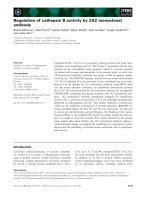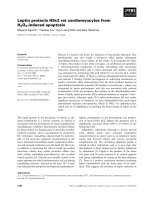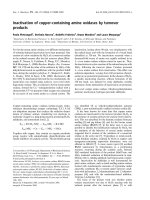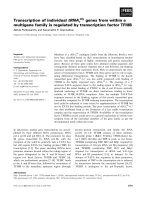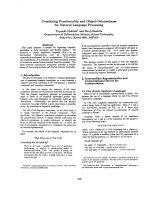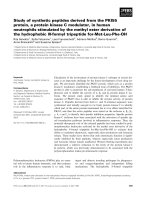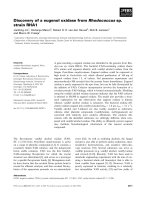Báo cáo khoa học: "Acquisition of Conceptual Data Models from Natural Language Descriptions" doc
Bạn đang xem bản rút gọn của tài liệu. Xem và tải ngay bản đầy đủ của tài liệu tại đây (644.52 KB, 8 trang )
Acquisition of Conceptual Data Models
from Natural Language Descriptions
William J.Black,
Department of Computation, UMIST,
PO Box 88, Sackville Street,
Manchester, M60 1QD, UK
Abstract
Acquiring information systems specifications from natural
language description is presented as a problem class that
requires a different treatment of semantics when compared
with other applied NL systems such as database and
operating system interfaces. Within this problem class, the
specific task of obtaining explicit conceptual data models
from natural language text or dialogue is being
investigated. The knowledge brought to bear on this task is
classified into syntactic, semantic and systems analysis
knowledge. Investigations with a simple syntactic parse
and with a semantic analysis using McCorcl's Slot Grammar
are reported, and the structure of the systems analysis
knowledge is considered.
1 Introduction
This section introduces the application of computer-based
tools for information systems requirements analysis, design.
and implementation, and outlines a motivation for
endowing such tools with natural language interfaces. It
concludes with the structure of the remainder of the paper.
Information systems development suffers from two widely
acknowledged problems:
• an applications backlog, whereby demand for
applications exceeds resources available for its
satisfaction.
• a requirements analysis problem. This is often
manifested as a maintenance problem, whereby
resources that could be put into reducing the
applications backlog are instead devoted to correcting
faults in delivered systems. Most such faults are
traceable to erroneous specifications, resulting from a
failure to establish user requirements correctly.
The industry has provided solutions to each of these
problems:
The problem of productivity has been addressed by the
provision of more powerful higher-level languages known
as 'application generators' or 'fourth generation languages '
(4GLs), in which the same functionality can be achieved in
a tenth or less of the instructions needed in a conventional
procedural computer language.
A general feature of such software tools is that they do
away with the need for much procedural programming by
employing
declarative
notations in which requirements can
be expressed in sufficient detail for the software to provide
procedures to meet them. (Naturally, the sophistication of
these declarative notations varies according to the breadth
of their application coverage.)
The requirements analysis problem has been addressed since
the mid nineteen-seventies by a range of prescriptive
development methods providing working procedures and
graphical representation languages, in place of traditional
approaches which rely heavily on natural language
narrative to specify prooessing requirements. A typical
representation or conceptual modelling language is
described in section 2.
A problem with both the high-level application generators
and the development methods is that they have been
established independently by a variety of manufacturers,
software houses, consultants and academics, resulting in a
multitude of competing products and methods, with no
standard accepted by the industry. Suppliers and users
therefore face considerable training and consultancy costs
due to staff mobility.
A more recent trend is to combine the two approaches to
produce a more powerful software tool environment or
analyst's workbench which enables the analyst to edit
diagrams that formally represent the requirements, and
using these specifications to automatically generate
computer programs. Such tools represent an improvement
on previous practice in two ways: firstly by bringing
forward the use of precise formal languages from the coding
to the specification phase in the software life-cycle, and
secondly by automating the coding phase. However, they
do not similarly
automate the
analysis phase that must
precede the formal expression of requirements in a
specification, although they may
mechanize the
process of
recording and revising a specification.
The nature of such tools is described in section 3.
It is proposed that a natural language interface to tools
provided to mechanize such methods would provide several
benefits:
It is possible to develop a specification using a
representation language with which the analyst is not
241
familiar, by
hiding the
representation language from
the analyst.
It can alternatively help the analyst
learn the
specification language by displaying the graphical
representation of a given description.
With a natural language generation facility it is
possible for an analyst to informally
verify
that a
graphical representation of some aspect of a system
expresses the desired meaning.
A natural language generator can be used to
translate a
specification developed by someone else using a
representation that the reader is not familiar with. In
addition to facilitating communication between
analysts ~ained on different methods, this technique
could facilitate communication between analysts and
their users or expert informants.
A further motivation is that increasingly, the 4GLs
described above are in the hands of end users who develop
applications directly. 4GLs typically make straightforward
applications easy to develop, often prompting the users for
the parameters that specialize the application as an
instance of the stereotype systems that lie within the tool's
application bandwidth. However, they are often poor at
enabling more elaborate requirements to be met where there
are interdependencies between data Ides and complex
integrity and validation rules. A tool built on the lines
described below cart help end users inexpert in analysis to
articulate their own requirements and then to convert those
requirements into executable code.
The architecture of an information systems development
workbench with an integrated natural language and graphics
interface is described in section 4. An approach to
knowledge representation within this system is discussed in
section 5. Approaches to natural language analysis and
generation and the results of some prototyping work
are
discussed in section 6.
Conceptual Data Models
Within system development methods, there exist several
notations for the representation of aspects of the
information processing systems. A comprehensive method
will be able to represent a conceptual model of the real and
abstract objects in the system's environment, the
functional requirements of the system, and its detailed
design and implementation. Methods differ according to
their emphasis on the data the system deals with or its
processing requirements. Here, we
will
only discuss data-
oriented approaches, and in particular Entity-Relationship
(ER) modelling(Martin 1984, MacDonald 1986), and the
Information Structure Diagram within NIAM (Verheijen
and
van Bekkum, 1982; Blank and Krijger, 1982), an approach
to conceptual modelling that claims to be directly informed
by considerations of the structure of natural language
sentences.
Both approaches started as paper-and-pencil notations for
unambiguously recording the systems analysfs
understanding of the relationships between objects that are
significant to the proposed computer system. Now,
however, both feature in interactive computer-based tools.
ER
analysis
is the cornerstone of several application
development toolkits, including the
Information
Engineering Workbench,
which uses such models as input
to a process that ultimately leads to automatic code
generation. Using this software, the analyst creates a model
of data objects and relationships, and then specifies how
programs will access this data by superimposing access
paths and conditions on the ER diagram to produce a 'data
navigation diagram' which can in turn be the input to an
automatic process of computer program generation.
The NIAM approach is somewhat different. It aims to avoid
altogether the need to describe the objectives of a computer
program prvcedurally. The NIAM conception is that if all
the relationships and dependencies among data objects are
specified rigorously, all events in the world
cart be
recorded
in the database by the assertion or retraction of 'sentences'
from the information base (database). Further, rules for
deriving information, such as that produced in reports, can
be included in the conceptual model. Under this approach,
the need for application programs is obviated, since 'all
computations may be executed under the control of the
information base handler instead of an application program'
(Blank and Krijger 1982, p 140). NIAM thus belongs to
the 'executable specifications' class of approaches to
system design. To illuslxate NIAM's modelling language,
we will use example sentences from a narrative in a
database examination paper (1) and (2).
(1) Customers send the company purchase orders for
pharmaceutical suppfies.
(2) Each order contains requests for quantities of many
different products which are all required for one shop.
2.1 NIAM Information Structure Diagrams
In this section, we describe the modelling constructs of the
NIAM information structure diagrwn (ISD). The derivation
of the model from natural language text is taken up in
section
6.
The NIAM method uses similar constructs to ERA
modelling, (employing different terminology) but at a more
atornistic level. Its perspective is derived
from
the
structures of natural language, on the justification that a
database comprises a set of
sentences
and the purpose of
the conceptual darn model is to specify a
grammar
of the
sentences allowed in a particular database (Blank and
Krijger, 1982). Relationships between objects have
associated with them two
role names,
one for each related
object.
Figure 1 shows how (1) and (2), together with some further
information about warehouses and picking lists, can be
represented in NIAM notation~
242
.as [for .
Figure 1 - NIAM Infornmtion Structurc Diagram
NIAM representations are constructed from objects and
relationships.
Objects are of two kinds: NOLOTs or NOn-Lexical Object
Types are concrete or abstract objects of reality, and LOTs
or Lexieal Object Types are objects of which occurrences
have values, i.e. they are names. NOLOTs and LOTs are
synonyms for entities and attributes, and are shown by
unbroken and broken circles respectively.
Relationships are associations between objects: either
between two NOLOTs or between a NOLOT and a LOT. They
are shown by lines connecting two circles. Semantically,
the relationship is the Cartesian product of the two related
object types. On the line are two rectangular boxes bearing
the name of the role each object plays in the relationship.
The concept of a role is similar to that of a case role in
linguistics (cf Fillmore 1968).
In addition to portraying objects and their relationships,
NIAM also explicitly represents constraints between these
objects.
Relationship degree is shown by double headed arrows
beside one or both roles. The relationship between
customer and purchase order in Figure 1 is a one to many
(I:N) relationship in that a customer may send many
purchase orders, but each order is only sent by one
customer. A many to many (M:N) relationship, such as that
between purchase orders and pharmaceutical supplies, is
shown by the arrow's spanning both roles. A one to one
(1:1) relationship has separate arrows alongside each role.
Whether a relationship is obligatory or not is also shown
in the diagram. The 'V' across the line between purchase
order and the 'sent-by' role indicates that a purchase order
cannot exist without being related in this way to a
customer, but the absence of such a symbol at the opposite
end of the relationship line shows that a customer can exist
without having any (current) purchase orders.
Additional constraints, such as subset and set inequality
constraints between objects, relationships or roles can also
be modelled on the NIAM ISD. For example, the arrow
linking pharmaceutical supplies to product indicates a
subset relationship.
Often, M:N relationships are indicative that further analysis
is required. Where such a relationship conveys genuine
information, it is usually helpful to resolve the
relationship into two I:N relationships, with a new entity
type between.
The M:N relationship in figure 1 between purchase order
and pharmaceutical supplies was derived from sentence (1).
In sentence (2), further information about orders was
supplied. All the information conveyed by the M:N
relationship is represented by the chain of I:N
relationships linking purchase order, request, product and
pharmaceutical supplies.
Tools for Conceptual Modelling
Many proprietary tools exist for editing conceptual data
models, e.g.
Excellerator, Information Engineering
Workbench, and Blues. The
system enables the user to draw
diagrams using a mouse input device. The user selects from
the symbols in the notation by clicking the mouse button,
moving the cursor to a desired location and clicking again.
Lines connecting symbols can be selected in the same way
and placed by clicking twice, to indicate the two symbols
the line connects.
Violations of the 'syntax' of the notation are policed by
the software.
Modifications to both the content and layout of a diagram
can be made by cutting and pasting. Annotating
components with their names and other attributes is done
by clicking on existing symbols to open a dialogue
window.
As the diagram is thus created and edited, the information
expressed in it is stored in a data dictionary (or
'encyclopaedia').
It can be argued that such an interface is so user-fi'iendly
that no case could be made for a natural language
alternative. However, it is emphasised that a tool as
described above is entirely passive. It simply records the
information fed into it, and can give no guidance as to the
correct way to represent a given state of affairs. It can only
be used by an expert in the method of analysis it
documents. For such an expert, it is probably an optimal
243
tool. However, we have noted in section I that owing to
the babel of alternative notations, there are circumstances
in which experienced analysts are required to use methods
they are not familiar with. This is the premise of the
AMADEUS project (Loucopoulos et al 1986, Black et a/
1987) which seeks to provide a facility for translating
between alternative method notations. Briefly, the
requirement to use unfamiliar methods can arise because of
job mobility, organizational take-overs, customers
dictating the method to be used by those who tender for
their contracts, and in the course of training.
It is also envisaged that the system will be used by end
users to develop applications without professional support.
Figure 1 illustrates, by the variety of special symbols used
and their connectivity, that for end-user application
development, notations like the N/AM ISD would require an
explanation facility to support comprehension, For a non-
expert to use such a notation constructively to devel6p a
specification also requires some form of expert assistance.
A f'mal motivation for building the system is that as an
integrated natural language and graphics interface,
it
provides a context in which the relative merits of the two
interface styles can be compaxed. As Thompson (1983) has
noted, almost no empirical work has ever been carried out
into the relative merit of natural language and graphic
interfaces.
I a°
user
nt¢
lyse
J
rfac~
gen~
I
"at r k Irill
)hics interf;
It
;e
pr
conceptual model manager
long-term session/spec.
knowledge-base database
Architecture of an integrated NL and
graphics environment.
Figure 2 - System components and data flows
4.1 Dialogue Structure
A natural interface using both text and graphics requires a
large bit-mapped screen and both keyboard and pointing
input devices. An Apollo DN3000 running Quintus Prolog
under UNIX has been selected as an environment for
development of the system. The intended dialogue structure
employs two windows, one for text and one for graphics.
In both cases, highlighting is used for attention focussing
and establishing correspondence between a diagram and
natural language narrative.
Text to graphics. Appendix A shows an hypothetical
dialogue where the user input is in the text window.
This dialogue owes much to the style of dialogue employed
in Nanok/aus (Haas and Hendrix 1983), and would suit a
very inexperienced or casual user. Someone more used to
expressing rules in unambiguous English might be able to
say most of the above in one sentence:
"A paper is written by one or more authors, one of
which must also be its presenter, and any of whom may be
the authors of other papers."
For this reason, the interface must have good syntactic
coverage and a formal semantic component that deals with
quantifier
seeping.
Graphics to text. A dialogue where the input takes
place in the graphics window proceeds as follows: The user
selects and places new symbols in the graphics window.
For each symbol added, the change is recorded in the
session database, and its internal representation is passed
to the language generation component, which produces an
English description of the effect of the changes. Suppose
for example, that the graphics window contains the first
drawing shown in Appendix A. The user then adds the V
symbol to produce the next drawing shown. In response,
the following text is produced:
"A paper must be written_by at least one author.
(Previously it could
apparently exist without being written
by an author.)".
Alternative uses of the natural language generation facility
exist. For example, a user could highlight a part of the
diagram and request a translation into English, or could
enter changes in a "what if" mode and have their
consequences explained.
4.2 System structure
To produce a dialogue such as that shown in Appendix A or
as described above, a system organization such as that
shown in figure 2 is required.
Both user interfaces must use the same internal
representation for the aspects of systems described
alternatively in text or graphics. This is discussed below.
The session/specification database is the counterpart of the
data dictionary in individual proprietary tools. In such a
system, the graphics interface is such an integral part of
244
the system that it along with the natural language interface
requires to be re-implemented.
5 Knowledge representation framework
It has been established in the separate AMADEUS project
(Black et a/ 1987) that a flame representation based on FRL
(Roberts and Goldstein, 1977) is capable of representing
all
the modelling constructs used in a range of requirements
specification notations. SpecificaLly, in the case of NIAM,
objects (lexical and non-lexical) and relationships are
represented by frames, and roles by slots. Constraints of
relationship degree and optionality are represented together
by facets of role slots.
As an example, Figure 3 shows a set of frames representing
some
of
the information about paper authorship shown in
Appendix A.
It is intended that a uniform knowledge representation
structure such as that shown in Figure 3 will be used
throughout the system, both for storing the facts gathered
in a session, and for representing the stored knowledge in
the system, including the dictionary.
paper (ako,valua,object)
(written_by,value,authorship)
author
(ako,value,object)
(writer_of,value,authorship)
authorship
(ako,value,association)
(written_by,domain ,paper)
(written_by,mln__card, 1 )
(written_by,max_card, 1 )
(writer_of,domain,aut hor)
(write r_of,min_card,O)
(writerof,rnax._card,N)
Figure 3 Internal representation of objects and
relationships.
6 Approaches to
NL analysis
and
generation
Haas and Hendrix (1983) describe a system where a
semantic network model of object classes, instances and
properties is constructed through a co-operative natural
language dialogue. In the early version, Nanoldaus, the
syntactic coverage is restricted to simple sentences in
which the user may assert propositions about the set
membership and other properties of objects.
(Enomoto et al 1984) describes a system in which an
unambiguous fragment of English (based on Montague's
PTQ) cart be used in a highly constrained way to describe
the desired behaviour of a system.
Other work on natural language understanding of descriptive
text has tended to use ad-hoc semantic grammars specialized
to the application domain. Norton (1982) describes a
program that acquires knowledge of the BASIC
programming language's syntax and semantics from a
textbook and uses this to generate an interpreter for part of
the language. In some respects, the goals are similar to our
own, but the semantic grammar approach used means that
little of that apporach is re-usable.
Less directly related to the system specification domain is
(Mellish 1985) which describes a system for the semantic
interpretation of mechanics problems expressed in English.
The program made use of the given/new distinction in
establishing the co-reference of definite and indefinite
descriptions, incrementally constructing extensional
semantic interpretations using intermediate intensional
reference entities.
Earlier work on text comprehension (e.g. de Jong, 1979)
concentrated on skimming techniques to match text content
against sketchy scripts. Such a grain of analysis is
inappropriate for present purposes.
6.1 Conceptual Modelling from NL Text.
The goal of conceptual modelling is to identify the
significant objects and relationships in the application
universe of discourse. As with other NLU tasks, this
requires knowledge of three sorts: syntax, semantics and
real-world knowledge. In this section, we discuss the
separate contribution each source of knowledge makes in
conceptual modelling.
Syntax. Martin (1984) has observed that there is a
simple mapping of surface syntactic categories onto the
components of ER modelling. Nouns correspond to entities
(objects), and verbs correspond to relationships (or in the
case of NIAM, with role names). On this basis, sentences
(3) and (4) would receive different analyses, as shown
below.
(3)
(4)
Customers send orders for products.
Customers order products.
The English description in (2) is much less directly helpful
in identifying relationships. The attachment of the relative
clause which are all required for one shop to order rather
than product, request or quant/ty cannot be decided on
purely syntactic grounds. Fmxher, that quam/ty is an
attribute of request rather than an entity in its own right
cannot be determined without extra-linguistic knowledge.
The requirements for a linguistic approach are that either is
is constructed in the same manner as Nanoklaus, to employ
simple input phrase structures, but embedded in a .co-
operative dialogue, or else it should have sufficient
linguistic coverage to handle the complex sentence
structures exhibited in (1) and (2). Most importantly in the
latter respect, it should have a reasonable treatment of the
variety of natural language quantifiers and relative clauses.
Many database interfaces have such capabilities, McCord
(1982), Dahl (1982) and Warren and Pereira (1982) inter
a//a.
245
Semantics. Chamiak (1983) makes a distinction between
inferential and non-inferential semantics. The former is
concerned with establishing the logical form
corresponding to a syntactic analysis of a sentence,
whereas the latter is concerned with co-oecurrence
restrictions between phrases which may be stated in terms
of lexical subcategories such as human, mass, machine,
etc.
Database interfaces are the most common instances of
complete natural language interfaces which comprise beth
syntactic and semantic components. As such they are
potential models for the development of interfaces to new
types of software systems. However, their approach
to
semantics cannot be imported wholesale. They avoid the
general theoretical problem of what a semantics of natural
language should consist of by an operational approach in
which the propositional content of a sentence is
represented by a database tuple, and lexical
subcategorization is implemented in application-specific
categories. The following dictionary entries, for 'order'
both as a noun and a verb have been encoded in the
notation used by (McCord 1982).
noun
(order,
ord(O no,Cust,Supp,C)
&item(O_no,Prod,Qty)
nil,
O_no:transaction,
[npobj(for):Prod:goods]).
verb
(order,
ord(O_no,Cust,Supp,C)
&item(C) no,Prod,Qty)
C,
Cust:prsn,
[obj:Prod:goods,npobj(from):Supp:prsn]).
Each of these dictionary entries has five components. The
first is the name of the word, the second is the
propositional meaning, the third a variable denoting time,
the fourth specifies the semantic subeategorization of the
word (in the case of nouns) or its subject (in the case of
verbs), and the last subeategorizes the objects or other
postmodifiers the word may take.
One danger with application-specific lexical
subcategorization is that it may be applied too
restrictively. For example, in the lexicon published in
(McCord 1982), subclasses are specifically restricted to the
database entities that can be expected in a query. For
example, the semantics of take are specified to expect a
student as subject and a course as an object. Such
restrictions are fine for database queries, such as (5) but a
question such as (6) cannot even be asked.
(5)
(6)
Which students took Logic?
Do lecturers ever take courses?
Real world knowledge. It is not possible to produce
an analysis such as that shown in Figure 1 without 'real-
world' knowledge in addition to a grammar and dictionary.
For example, the knowledge that pharmaceutical supplies
are a subset of products is required to link the information
acquired from the analyses of (1) and (2). The full extent to
which real-world knowledge will be required in the system
is not known, but it is assumed that the sort of notation
shown in Figure 3 can be employed to encode arbitrary real-
world knowledge for the system.
The boundary between what is linguistic knowledge and
what
is real-world knowledge is not a clear one. In the
sample dictionary entries for order, we have shown that
corresponding to an order, there is also an item. This was
necessary so that the type of object can be linked to an
argument place in the predication. It can be argued that this
amounts to non-linguistic knowledge that orders typically
comprise several distinct items.
Adapting
a database Interface. An initial prototype
system for inferring the existence of entities and
relationships from natural language descriptions is being
constructed using McCord's Slot Grammar (McCord 1982),
selected for its syntactic coverage and trealanent of a
variety of natural language quantifiers.
To adapt the form of lexieal entries in the McCord parser
from the database query task to the present one, generic
definitions of word meanings have been provided, allowing
a wider range of assertions to be made.
Results. With these defindons it has been possible in a
rudimentary way to determine the existence of some
relationship types between entities to build simple ER
models. This is done by examining the attributes of the
relational database predicates in the parse tree. The
existence of a relationship between two database relations,
is indicated by the sharing of attributes. If the identifier of
one relation occurs as a non-identifying attribute in another
relation, we may infer a I:N relationship between them.
For example, in the following parse of the sentence
"enstorners order products" the variable _133 is common to
both order and customer:.
[customers,order,products,.]
[s,dcl] main ord(_195,_133,_197,_198)
[np,pl] indef:_133:prsn cnst(__133,__134,_135)
[advc] conjunct present(__198)
[np,pl] indef:_199:goods prod(__199,__244,_245)
This occurs precisely because the dictionary entry for
"order" explicitly provided for the identier of the subject to
be an argument of the predication.) The sharing of the
arguments tells us that a relationship exists between the
entity order and the entity customer, and furthermore, it is a
I:N relationship from customer to order, since the shared
argument is the whole key of customer, and either a non-
key or part key in order.
Current status of project. The prototyping activity
described above is ongoing, but in parallel, the overall
design is being elaborated, and a purpose-built parser based
on LFG is being implemented in Prolog. Work on the
246
generation component has not yet commenced.
7 Summary and Conclusions
This paper has outlined an application area that can serve
as a test-bed for work on the processing of natural language
text for the purpose of knowledge acquisistiort, a problem
that is
much
wider than the
specific case
of information
systems design. The role of natural language analysis and
generation within an environment that
also supports
a
WIMPs (Windows, Icons, Mice and Pointers) interface was
defended, and the architecture of the software outlined.
Finally, the relative place of syntactic, semantic and real-
world knowledge in conceptual modellingwas discussed, and
the adaptation of a
database
interface
to
the analysis
component of the system was describe&
Acknowledgements
Edem Williams carried out some lexieographic work and
implemented a version of the
McCord
Slot Grammar parser,
and carried out some preliminary work on identifying
objects and relationships under this approach. I am
grateful to Donal Flynn for discussions about NIAM.
References
Black, W.J, Sutcliffe, A.G., Loucopoulos, P and Layzell,
P.J. (1987) Translation between pragmatic software
development
methods.
Submitted
to
ESEC87,
Strasbourg.
Blank and Krijger (eds) (1982). Evaluation of methods and
techniques for the analysis, design and
implementation of information systems., Academic
Service, pp 137-156.
Dahl,V (1982) On database systems development through
logic, ACM Transactions on Database Systems 7, 1(Y2-
123
Enomoto, H, Yonezald,N, Saeki, M and Aramata, H (1984)
Natural Language Based Software Development System
TELL, ECAI-84.
Fillmore, C J (1968) "the Case for Case' in Bach and Harms
(eds) Universals in Linguistic Theory, Holt, Reinhart
and
Winston.
Haas, N and Hendrix, G.G. (1983) Knowledge acquisition
from Interactive Dialogue, in Michalski, Mitchell and
Carbonell (eds) Machine [.earning
I,
Tioga.
Loucopoulos, P; Black, W.J; Layzell, P.J; Suteliffe, A.G.
(1986) AMADEUS : A multi-method approach to
developing universal specifications. Paper presented
to ESPRIT Technical Week, September 1986.
MacDonald, I.G. (1986) Information Engineering An
Improved, Automatable Methodology for the design of
Data Sharing Systems, In Olle, T.W et al (eds)
Information Systems Design Methodologies:
Improving the Practice, North-Holland.
Martin, J. (1984) Information Engineering, S avant
Institute.
McCord M.G. (1982) Slots and Modifiers in Logic
Grammars, Artificial Intelligence 18, 327-367.
Mellish, C (1985) Computer Interpretation of Natural
Language Descriptions, Ellis Horwood.
Norton. LM. (1982) Automatic Analysis of Instructional
Text, Artificial Intelligence 20, 307-344.
Thompson, H (1983) Natural language processing: a
critical analysis of the field, with some implications
for parsing, in Sparck-Jones and Wilks (eds)
Automated Natural Language Parsing, Ellis Horwood,
Chichester.
Verheien, G.M.A and van Bek~tm, J (1982) NIAM: An
Information Analysis Method, In Olle, T.W et al (eds)
Information Systems Design Methodologies: A Feature
Analysis, North-Holland.
Warren, D.H.D and Pereira, EC.N (1982) An efficient
easily adaptable system for interpreting natural
language queries AJCL 8, 110-122.
Appendix A
Sample dialogue
us~ A paper can be written by several authors
Must a paper be written by at least one author?
user yes
How would you describe the role of the author with
respect to the paper, e.g.
The author __s the paper, or
The author is of the
paper?
user walter_of
Can the author be the writer of other papers?
~ yes
~itten by wpter
of
247
s~ ok
user The paper
must be present~l by
one of the authors.
en_by ~e~of
248


